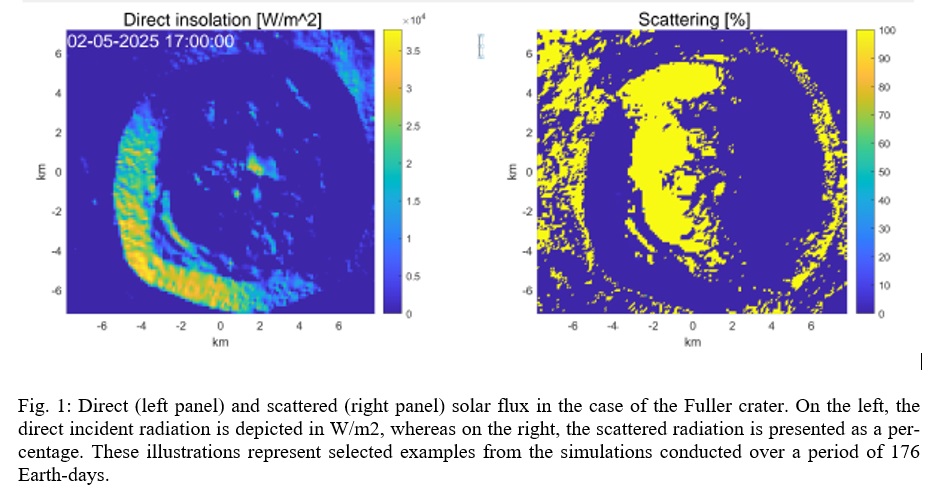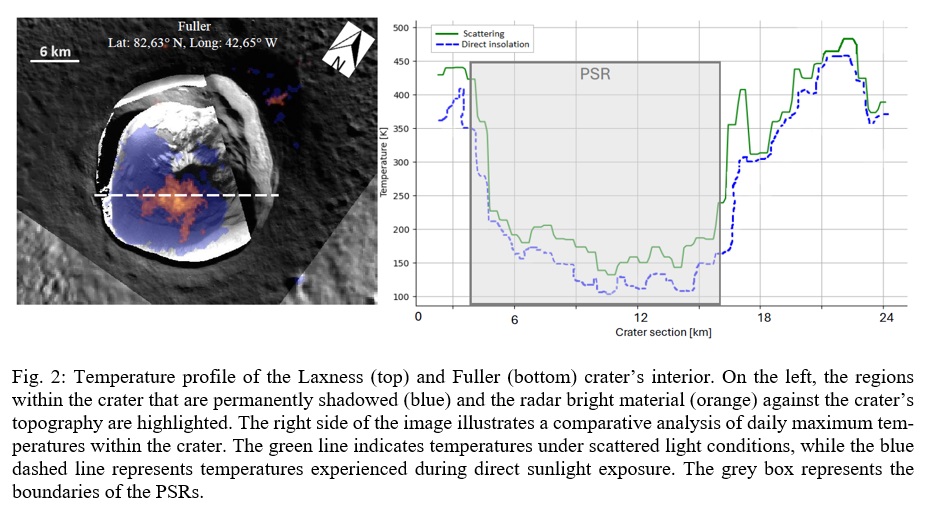The thermal impact of the self-heating effect on airless bodies. The case of Mercury’s north polar craters.
- 1INAF Astronomical observatory of Padova, Vicolo dell'Osservatorio 5, 35122 Padova, Italy (pamela.cambianica@inaf.it)
- 2Department of Geosciences, University of Padova, Via Giovanni Gradenigo 6, 35131 Padova, Italy
Introduction: Earth-based radar observations revealed areas within Mercury’s north polar regions with peculiar high radar backscatter [1,2]. The presence of this radar-bright material was interpreted as water ice within permanently shadowed regions (PSRs) because the radar characteristics resemble those observed for the Martian polar ice caps. [3] indicated that Mercury’s polar environment is capable of hosting stable water-ice-deposits over geologic time-scales. Later, the MErcury Surface, Space ENvironment, GEochemistry, and Ranging (MESSENGER) mission has suggested that these radar-bright materials are predominantly composed of water ice. The detection, global mapping, and analysis of the composition of PSRs with an unprecedented high-resolution are among the primary scientific goals of the Spectrometer and IMagers for MPO Bepicolombo Integrated Observatory SYstem (SIMBIO-SYS) suite [4].
Understanding these features can provide key insight into the evolution and composition of Mercury’s volatile polar deposits. However, interpretation of the highest-resolution images of Mercury’s polar deposits is limited by the availability of illumination and thermal models. In fact, estimation of illumination conditions and calculation of the surface radiative intensity on the surface of Mercury are fundamental to study the effect of the insolation weathering affecting the PSRs. These areas can receive only scattered light, emitted thermal energy from the surrounding topography, and thermal energy from Mercury's interior. To obtain the surface and subsurface temperature distributions of an airless body, any thermophysical model than aims to consider realistic physical conditions such as topography, orbital elements, surface roughness, and thermophysical parameters (e.g., thermal inertia or thermal conductivity) needs to consider two illumination cases occurring on a surface: 1) the direct and 2) the scattered sunlight cases. In the case of Mercury, the solar disk cannot be approximated as a point source, and the back scattered light needs to be considered. This allows to quantify the self-heating effect, which results from the absorption of thermal radiation by elements of the topography from surrounding visible portions. As a result, the coldest facets can be heated by the hotter ones, increasing the total amount of insolation received by the surface.
In this work we aim to quantify the thermal impact of incorporating scattering and self-heating effects into simulations of temperature distribution on airless surfaces. Our focus is on the Laxness (83.27°N 50.04°W, diameter 27 km) and Fuller (82.63°N, 42.65°W, diameter 25.9 km), craters, situated in the northern regions of the Goethe Basin.
These craters, with their unique shapes, depths, and rim heights, offer valuable insights into the interplay between sunlight scattering, shadowing effects, and thermal behavior in extreme conditions. By examining these craters, we aim to enhance our understanding of the thermal processes at play in Mercury’s polar regions, contributing to a more comprehensive model of planetary surface temperatures.
Method: To investigate the role of the self-heating effect on the PSRs we developed a ray-tracing illumination and 3D Eulerian thermal model. Calculations were performed by using local Digital Terrain Models (DTMs), generated by [5], of Mercury’s north polar craters with a resolution of 125 m/px. The crater DTM was used as input of the solar illumination model. The model is based on the ray-tracing technique and treated the Sun as a disk and not as a point source due to the proximity of Mercury to the Sun. This illumination model allows to trace solar rays to each point on the DTM evaluating the direct illumination throughout a Mercury solar day. Meshes are then input into the 3D thermal model and the model is given an initial temperature based on latitude. The thermal model computes the surface temperature of each facet of the geometry as it evolves over time. The temperature is calculated by balancing direct insolation, multiple scattering of visible and infrared radiation from other facets, infrared emission, and 1D subsurface heat conduction. The effect of terrain shadowing is included.
Results: Figure 1 shows an example of how scattering affects the dispersion of energy received by the crater’s surface is illustrated. On the left, the direct radiation in W/m2 at a specific epoch can be observed, having simulated a period of 176 Earth-days. On the right, the areas of the crater where radiation is scattered (indicated as a percentage) are highlighted. There are regions that are impacted by solar flux through indirect insolation, due to the craters’ morphology. In order to understand how scattering affects the crater’s temperature, particularly in the PSRs, we calculated the temperature variation over the same time range. An example of maximum temperature profiles for the Fuller craters are presented in Fig. 2. For those plots, we developed an ad hoc method that allows us to extract a temperature profile from a heat map at a specific epoch, enabling the analysis of temperature variations for each pixel. This approach allows us to quantify even the smallest temperature changes. Additionally, in Fig. 3 the area where PSRs occur is indicated to enable accurate selection of the profile and facilitate the comparison with areas affected by direct radiation. There is a noticeable increase in temperature greater than what is observed in areas that receive direct illumination. To better quantify this effect, we averaged the maximum temperature variation between the two scenarios and calculated the percentage variation over the 176 Earth-days. For Laxness we found that the data cluster around the 15% average variation. On the contrary, the Fuller crater exhibits values around the 10% average variation. Each measure corresponds to a single day’s maximum temperature variation within the PSRs.


Acknowledgments: we gratefully acknowledge funding from the Italian Space Agency (ASI) under ASI-INAF agreement 2017-47-H.0
References: [1] Slade, M. A., Butler, B. J., & Muhleman, D. O. (1992). Science, 258(5082), 635-640. [2] Butler, B. J., Muhleman, D. O., & Slade, M. A. (1993). Journal of Geophysical Research: Planets, 98(E8), 15003-15023. [3] Paige, D. A., Wood, S. E., & Vasavada, A. R. (1992). Science, 258(5082), 643-646. [4] Cremonese, et al. 2020, Space science reviews, 216, 1. [5] Hamill, et al. 2020, The Planetary Space Science journal 1.3:57. [6] Deutsch, et al., 2016a, Icarus 305, 139-148.
How to cite: Cambianica, P., Simioni, E., Cremonese, G., Bertoli, S., Martellato, E., Lucchetti, A., Pajola, M., Re, C., Tullo, A., and Massironi, M.: The thermal impact of the self-heating effect on airless bodies. The case of Mercury’s north polar craters. , Europlanet Science Congress 2024, Berlin, Germany, 8–13 Sep 2024, EPSC2024-337, https://doi.org/10.5194/epsc2024-337, 2024.